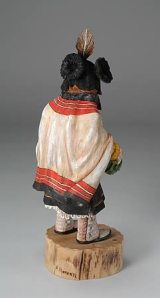The Story of the Hopi Kachina Eototo
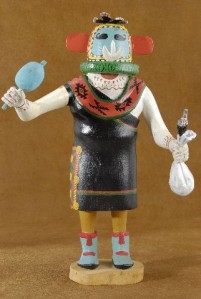 One of the kachinas that appears each year is Eototo. On each of the three mesas he is the spiritual counterpart of the Village Chief and as such is called the “father”of the kachinas. He is the chief of all kachinas and knows all ceremonies. At Third Mesa during the Powamu Ceremony, Eototo and Aholi come out of the Chief Kiva. Eototo always leads, and he draws cornmeal symbols of clouds on the ground. Aholi places his staff on the symbol and waves it in an all-encompassing fashion while giving a long call. This performance is the blessing of the village and marking it so that the clouds will come into the pueblo. A ceremonially prepared hole in the plaza is marked with cornmeal lines leading to it for the clouds to follow, and then water is poured into the hole which represents the town cisterns. The water is from Eototo’s gourd of sacred water. Arriving at the Powamu Kiva where the Crow Mother awaits, Eototo again draws lines leading to the hatchway from the different directions and then pours water from his gourd into the hatchway where it is caught in a basin by the Powamu Kiva Chief below. At each blessing Eototo is given prayer feathers and the kiva chief takes some of the corn sprouts that he carries under his arm. Aholi faithfully repeats each action. Again these actions are to bring water to the village and it’s growing crops., symbolized by the bean sprouts in the kiva. The role that Eototo plays in each ceremony is complex and is only briefly summarized here.
One of the kachinas that appears each year is Eototo. On each of the three mesas he is the spiritual counterpart of the Village Chief and as such is called the “father”of the kachinas. He is the chief of all kachinas and knows all ceremonies. At Third Mesa during the Powamu Ceremony, Eototo and Aholi come out of the Chief Kiva. Eototo always leads, and he draws cornmeal symbols of clouds on the ground. Aholi places his staff on the symbol and waves it in an all-encompassing fashion while giving a long call. This performance is the blessing of the village and marking it so that the clouds will come into the pueblo. A ceremonially prepared hole in the plaza is marked with cornmeal lines leading to it for the clouds to follow, and then water is poured into the hole which represents the town cisterns. The water is from Eototo’s gourd of sacred water. Arriving at the Powamu Kiva where the Crow Mother awaits, Eototo again draws lines leading to the hatchway from the different directions and then pours water from his gourd into the hatchway where it is caught in a basin by the Powamu Kiva Chief below. At each blessing Eototo is given prayer feathers and the kiva chief takes some of the corn sprouts that he carries under his arm. Aholi faithfully repeats each action. Again these actions are to bring water to the village and it’s growing crops., symbolized by the bean sprouts in the kiva. The role that Eototo plays in each ceremony is complex and is only briefly summarized here.
Navajo Squash Kachina Doll Meaning
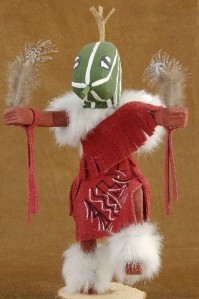 The Squash or Patung Kachina doll is known as the plant Kachina. They bring their own water for planting to ensure a plentiful crop. He is also considered a chief kachina.
The Squash or Patung Kachina doll is known as the plant Kachina. They bring their own water for planting to ensure a plentiful crop. He is also considered a chief kachina.
The Red Tail Hawk Kachina Meaning
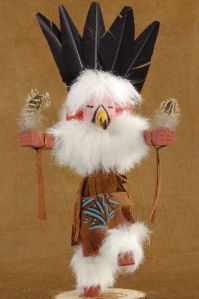 Although rarely seen, the Red Tail Hawk Kachina (also known as a Chief Kachina has many different purposes. This Kachina can be mainly seen in the Pachavu ceremonies. He serves as both hunter and warrior. The Pachavu ceremony serves as a dramatization of historical events.
Although rarely seen, the Red Tail Hawk Kachina (also known as a Chief Kachina has many different purposes. This Kachina can be mainly seen in the Pachavu ceremonies. He serves as both hunter and warrior. The Pachavu ceremony serves as a dramatization of historical events.
What is the Powamu Ceremony?
The powamu ceremony is one of the most important Hopi ceremonies. It occurs in February of each year in most of the Hopi villages. In actuality it is not a single ceremony but a cluster of several important events that are interwoven. Most years the ceremony is presented in an abbreviated form. However, In years when the tribal initiation of the young men is held, the Pachavu Ceremony will be attached to the Powamu, and the ceremony is presented in its full, unabridged form.
Undoubtedly the most important aspect of the Powamu ceremony is the anticipation of the coming growing season, with ritual designed to promote fertility and germination. To accomplish this the Powamu chief appears as Muyingwa, the principal deity of germination, and every male who how has been initiated into the Kachina cult is expected to grow beans in the kivas. The growing of these bean sprouts gives the ceremony its popular name, and offers omens for the success for the growing season. The ceremonial processionof the Pachavu Manas carrying these bean sprouts and the presentation of ritual bundles of them to the women and children during the height of the winter are tangible evidence of the presence of Muyingwa. Second in importance is the initiation of the children into the Kachina society at this time. Powamu officers serve as fathers of the kachinas at this time reinforcing the relationship between the Powamu and Kachina Cult.
Incorporated into the Powamu are historical or mythological events which are given as dramatic presentations. The relationships between the Village chief and his clan with the clans of the pother chiefs are emphasized. Most of these events are accompanied by the impersonation of a great many Chief Kachinas. These presentations allow all men and kachinas in positions of authority before the village.
In addition to these rites there is a strong educational aspect that appears throughout the entire ceremony. The incorporation of the Soyoko ceremony with its disciplinary emphasis on the younger children and the feeling that all have bought their lives for another year is a part of this. The whipping of the children who are initiated to emphasize the need for secrecy might also be included.
The presentation of these rituals brings forth an enormous number of kachinas. Some of these are present but never be seen by outsiders or, for, that matter, by most of the Hopis. Other kachinas appear only during Pachavu or Initiation or at irregular intervals.
Navajo Wolf Kachina Symbolic Meaning
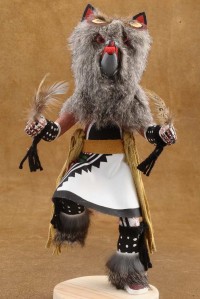 The wolf kachina appears in the mixed dance and the water serpent ceremony. He is a side dancer in the Soyohim dances. The wolf is considered a great pack hunter who helps and guides the hunters on large combined hunts. After the dances the Wolf is offered cornmeal or ceremonial prayer feathers, so the tribes may learn from him and secure game on their hunt.
The wolf kachina appears in the mixed dance and the water serpent ceremony. He is a side dancer in the Soyohim dances. The wolf is considered a great pack hunter who helps and guides the hunters on large combined hunts. After the dances the Wolf is offered cornmeal or ceremonial prayer feathers, so the tribes may learn from him and secure game on their hunt.
Ahulani Kachina Folklore and Meaning
Ahulani makes his quiet appearance rather late in the afternoon of the sixth day of the Soyal Ceremony when he rises rather than creakily from one of the kivas with his two maidens. He and his two maids function almost exactly as does the Soyal Kachina of third mesa in that no other kachina may appear before them. In essence he is the announcer of the coming Kachina season just as is Soyal. However, Ahulani, Kachina Mana and Sakwap Mana appear during the Soyal rather than sixteen days before. Together the trio arrange themselves near the Kiva hatchway and face east. Ahulani plants his staff firmly on the ground and they begin to sing. As each chorus is finished they pace slowly forward a step for each part of the song until it is completed. Making his dignified way to the plaza, followed by the two manas with their burdens of corn, he repeats the same ritual there and in other parts of the village, before they return to the kiva and disappear. This ceremonial circuit of the village, bearing token corn, is the last act before the seed corn that has been concentrated in the kiva is returned to the owners . Ahulani appears in two very distinct forms; one variety is seen only on the years when the Snake Dance is held on first mesa and the other when the Flute Dance is held on that mesa. As he accompanied by maidens bearing seed corn in trays, Ahulani does not carry a tray in this performance. Rather he holds a staff in his right hand and chieftain gear in his left hand.
The Navajo Warrior Kachina Doll Information and Meaning
 The Warrior Kachina is most often seen as a guard during the Powamu and Pachava ceremonies. Occasionally he appears as a warrior against the Clown Kachinas. He also serves as a policeman to oversee the cleaning o f the springs. The Warrior Kachina is also known as the Ewior Kachina.
The Warrior Kachina is most often seen as a guard during the Powamu and Pachava ceremonies. Occasionally he appears as a warrior against the Clown Kachinas. He also serves as a policeman to oversee the cleaning o f the springs. The Warrior Kachina is also known as the Ewior Kachina.
The Mastop Hopi Kachina Folklore and History
 The Mastop Kachina is the second kachina to appear on Third Mesa. He is not present on Second or First Mesa. These Kachinas always arrive in pairs and come bounding out of the northwest on the next to the last day of the Soyal. As they rush into the village they beat all the dogs that they encounter using the short black and white staff which they carry for that purpose. Leaping about with many antic gestures, they make their way to the Chief Kiva where they talk in disguised voices with the Chief Kiva where they talk in disguised voices with the individuals inside and with each other. Then, as though suddenly becoming aware of the females in the audience, they dash madly into a cluster of women and grab their shoulders from behind and they give a series of small hops indicating copulation. Then they return to kiva and converse for a while before again dashing over to another group of women, repeating the action until nearly every woman present from child to the very oldest has been approached. All women, even the shy ones, do not avoid this embrace as it is a serious fertility rite despite the antic touches, which are never directed towards the women.
The Mastop Kachina is the second kachina to appear on Third Mesa. He is not present on Second or First Mesa. These Kachinas always arrive in pairs and come bounding out of the northwest on the next to the last day of the Soyal. As they rush into the village they beat all the dogs that they encounter using the short black and white staff which they carry for that purpose. Leaping about with many antic gestures, they make their way to the Chief Kiva where they talk in disguised voices with the Chief Kiva where they talk in disguised voices with the individuals inside and with each other. Then, as though suddenly becoming aware of the females in the audience, they dash madly into a cluster of women and grab their shoulders from behind and they give a series of small hops indicating copulation. Then they return to kiva and converse for a while before again dashing over to another group of women, repeating the action until nearly every woman present from child to the very oldest has been approached. All women, even the shy ones, do not avoid this embrace as it is a serious fertility rite despite the antic touches, which are never directed towards the women.
